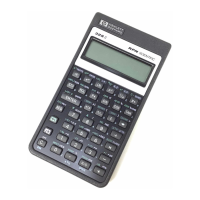The Automatic Memory Stack 2–15
File name 32sii-Manual-E-0424
Printed Date : 2003/4/24 Size : 17.7 x 25.2 cm
Order of Calculation
We recommend solving chain calculations by working from the innermost
parentheses outward. However, you can also choose to work problems in a
left–to–right order.
For example, you have already calculated:
4
÷
[14 + (7
×
3) – 2]
by starting with the innermost parentheses (7
×
3) and working outward,
just as you would with pencil and paper. The keystrokes were 7
3
y
14
2
4
Z
p
If you work the problem from left–to–right, press
4
14
7
3
y
2
p
.
This method takes one additional keystroke. Notice that the first intermediate
result is still the innermost parentheses (7
×
3). The advantage to working a
problem left–to–right is that you don't have to use
Z
to reposition
operands for nomcommutaiive functions (
and
p
).
However, the first method (starting with the innermost parentheses) is often
preferred because:
It takes fewer keystrokes.
It requires fewer registers in the stack.
Note
When using the left–to–right method, be sure that no more
than four intermediate numbers (or results) will be needed at
one time (the stack can hold no more than four numbers).
The above example, when solved left–to–right, needed all registers in the
stack at one point:
Keys: Display: Description:
4
14
)
Saves 4 and 14 as intermediate
numbers in the stack.

